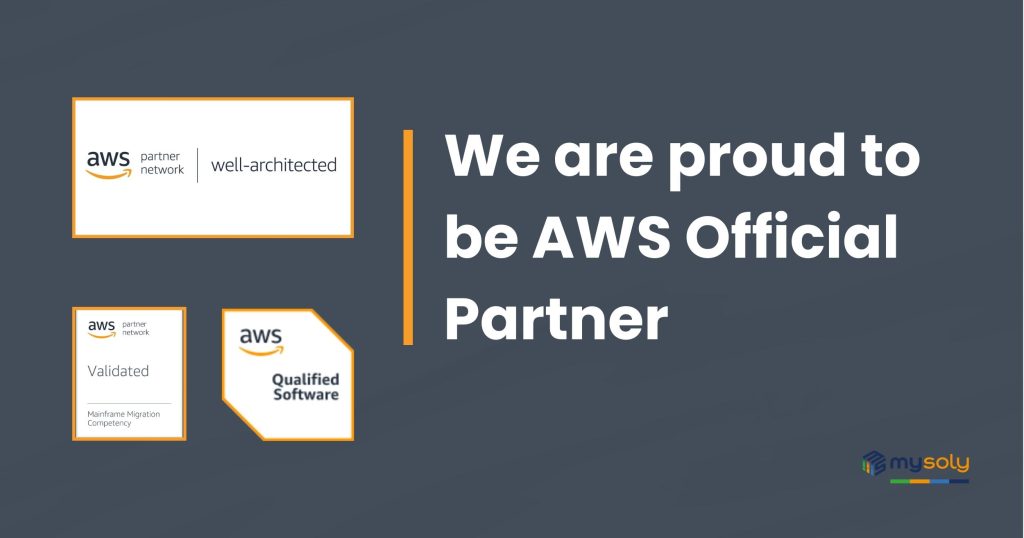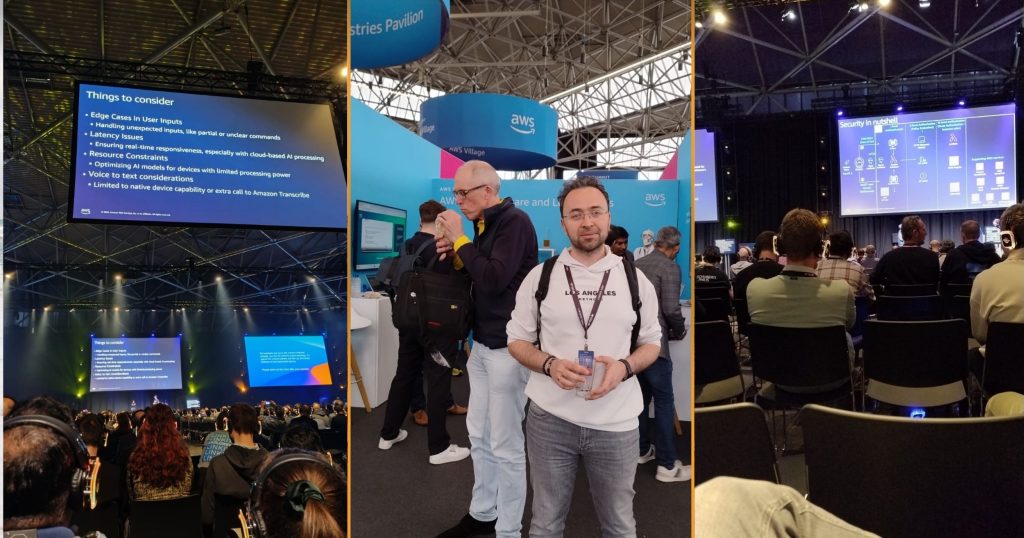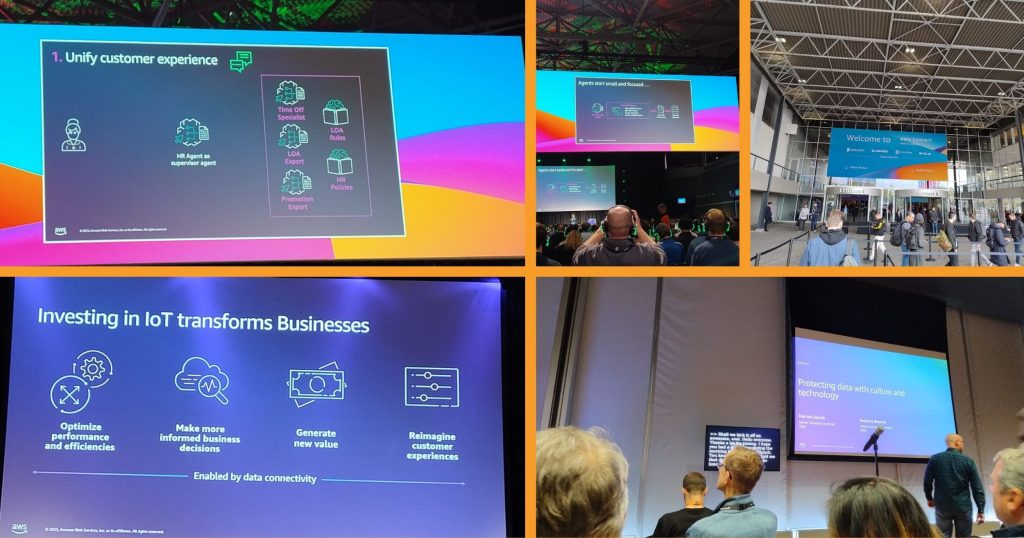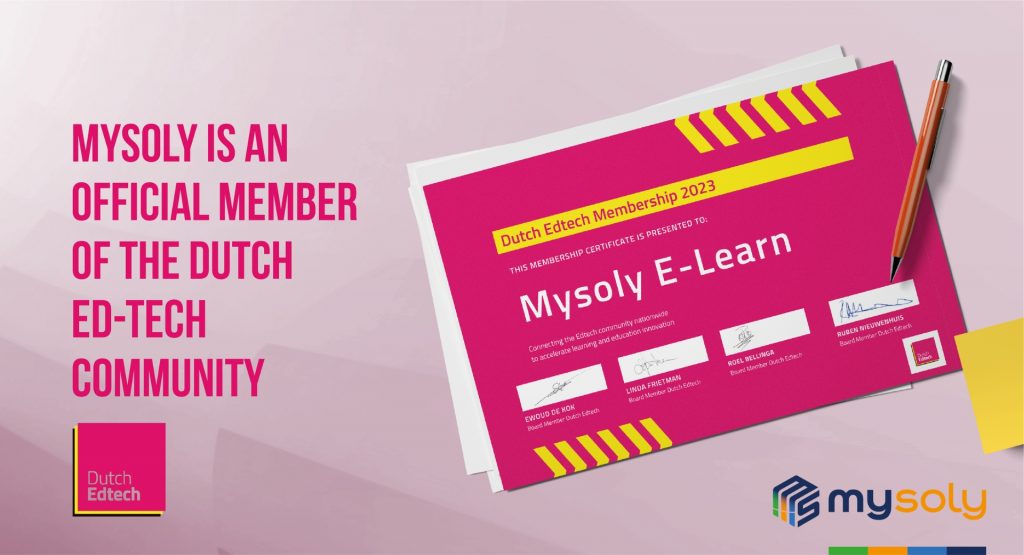Inside AWS Summit Amsterdam 2025: Key trends and highlights
We attended the AWS Summit Amsterdam 2025
Date: 16 April 2025
Keywords: AWS Summit, AWS Edtech, AWS Nova reel, AWS Nova Sonic, Gen AI
Place: Amsterdam
On April 16, 2025, the AWS Summit Amsterdam once again proved itself as the go-to destination for cloud innovation, digital transformation, and hands-on exploration of next-gen technologies. As Mysoly, we were proud to be there in person and immerse ourselves in over 100 sessions featuring experts, cutting-edge demos, and real-world case studies.
This year, one theme stood out across every hall, keynote, and technical discussion: “Multi-Agent Collaboration in the Age of Generative AI.”
From that perspective, here are some of the most important insights and takeaways we gathered during the event:
The shift from “Using Gen AI” to “Engineering with multi-agent architectures”
It’s no longer about whether to use generative AI in industries like education, healthcare, and finance. The focus has now shifted to how to orchestrate multi-agent systems that transform intelligent prompts into real business value.
We explored AWS solutions that make agent collaboration and orchestration easier than ever. With multi-agent frameworks, large tasks are broken down into subtasks handled by specialized agents:
- One agent translates text to SQL.
- Another interprets the SQL output.
- A third agent turns the results into marketing insights.
- All of them are coordinated under a central “router” agent, ensuring optimized response flow.
This architecture offers stronger, more relevant responses, reducing hallucinations and improving performance, especially when fine-tuned with domain-specific data.

Smarter, more personalized chat applications are here
Conversations are evolving far beyond simple back-and-forth interactions. One of the most striking developments discussed at AWS Summit Amsterdam 2025 was the transformation of traditional chat applications into highly personalized, multi-modal experiences.
Voice-enabled interfaces
Classic text-based chat applications can now be effortlessly upgraded to support voice input. This shift not only boosts accessibility but also creates a more natural and convenient user experience.
Personalized responses with contextual awareness
Modern chat systems are capable of adapting in real time by leveraging contextual user data. Inputs such as the user’s IP address, time zone, and even education or language proficiency can be attached to every request. This enables the system to tailor responses that align with the user’s tone, comprehension level, and expectations, ultimately enhancing user satisfaction.
Dynamic query categorization
Requests can be categorized instantly, triggering the most relevant agents or APIs depending on the nature of the query. Whether it’s customer support, product marketing, or healthcare advice, the right logic is activated, ensuring more accurate and context-specific responses.

Interactivity through camera and visual inputs
Enabling camera integration or allowing users to upload images significantly increases engagement. These features open up opportunities for visual-based support, identity verification, and even educational assistance powered by image recognition.
The role of testing in Gen AI applications
As generative AI gets embedded into more applications, the importance of testing cannot be overstated. Proper test coverage, especially including edge cases, is crucial to ensure performance, reliability, and user trust.
Responsible Gen AI requires robust testing
With Gen AI powering critical applications, testing is no longer optional, especially for edge cases.
You must:
- Include extreme usage scenarios in QA cycles.
- Fine-tune models (e.g., LLMs in healthcare) with domain-specific data to ensure compliance and trust.
- Design clear agent workflows to prevent performance drops and hallucinations.
Bad architecture leads to cluttered code, increased latency, and user dissatisfaction.
Solution: Multi-agent collaboration with small, fast supervisors managing specialized, heavier agents.

Gen AI for healthcare: Lessons from EdTech, applied with precision
At AWS Summit Amsterdam 2025, one key message was clear: industry boundaries are fading. Technologies that revolutionized education, such as generative AI, multi-agent systems, and cloud-native architectures, are now reshaping the healthcare sector.
From EdTech to HealthTech: Different use cases
While the use cases, regulations, and user expectations may differ across industries, the underlying tech stack and architectural patterns often remain the same. This is especially true for generative AI applications. What makes the real difference in healthcare is domain adaptation. Using a healthcare-specific fine-tuned LLM ensures not only better accuracy but also safer and more compliant results.
The critical role of multi-agent collaboration
Building intelligent systems that handle complex healthcare scenarios requires more than just large models—it requires smart design. Without clear task distribution and coordination, multi-agent systems can quickly devolve into chaos: bloated, unmaintainable codebases, slow responses, and hallucinating agents.
The solution? Multi-agent collaboration with a central orchestrator.
A lightweight, fast router agent can delegate tasks to specialized, heavier agents based on context. This structure ensures:
- Scalable and modular design
- Reduced latency
- Minimal hallucination
- Clear traceability
However, beware: poorly designed agent graphs with circular waits or bottlenecks can paralyze your system. Architectural clarity is not optional—it’s critical.
AWS well-architected framework & embedded security
Security is non-negotiable.. The AWS Well-Architected Framework helps teams assess and optimize their applications around core pillars like security, reliability, and performance. It’s not just about compliance, it’s about building prestige through trust.
Security should be embedded within the development team itself. One effective strategy is to build a security matrix that measures team-wide awareness and response to vulnerabilities. This shifts security left, making it part of design, not just deployment.

More than DDoS protection: The power of Cloudflare
Many know Cloudflare for its DDoS protection, but it’s now a full-stack development platform. You can build serverless apps, manage databases, run LLM workloads, trigger step functions, and send reliable messages under one roof.
It even supports multiple open-source LLMs, from LLaMA to Mistral, giving developers flexibility in AI model deployment.
Gamification: Now a must in learning experiences
Whether in EdTech or healthcare training, gamification is no longer optional. Interactive labs, storytelling, and progress-driven incentives significantly boost engagement and retention. Learning should be enjoyable and effective.
Managing complexity with third-party tools + Gen AI
Enterprise applications often rely on dozens of third-party tools. One example: static analysis tools (SAST) help detect vulnerabilities in source code, but they often generate false positives. Developers waste time chasing ghost issues.
Gen AI can drastically reduce noise by validating findings, ensuring developers focus only on true vulnerabilities. This minimizes friction and boosts productivity.
IoT + AI = Smarter and safer applications
IoT integration brings immense value to modern apps—but it’s not plug-and-play. Managing device connections, ensuring secure communication, and ingesting real-time data are all major challenges. Once data flows in, the next step is clear: AI-powered analysis.
But don’t think of IoT as one-way. With the right logic, data from devices can also be used to control or optimize those very devices, or entirely different systems.
In healthcare, regulatory hurdles and security concerns often complicate IoT adoption. But with the right architecture, the benefits outweigh the risks:
- Data collection becomes cost-efficient
- Products launch faster
- Marketing and iteration cycles shrink
- Human intervention is only needed for alerts; automation handles the rest

AWS Nova: The silent revolution
Technology is evolving so fast that even seasoned professionals nearly missed the launch of AWS Nova models. Huge thanks to AWS for not only reminding us of these models but also delivering them with an impressive price-to-performance ratio.
2025 has become the year when Generative AI started delivering true business value. Those who built PoCs in 2023 and turned them into real products in 2024 are now reaping the rewards. This shift has become a powerful source of motivation for the entire tech community.
At the same time, some companies using Gen AI faced scalability issues due to high product costs, which made their solutions unsustainable. This challenge sparked the rise of smaller, more efficient models like AWS Nova Micro, designed for cost-effective, real-time applications without compromising quality.
What’s more, AWS Nova Reel, a new tool that generates two-minute videos from text prompts, is set to launch very soon.
And coming up next is AWS Nova Sonic, a speech-to-speech model that promises to be a game changer in voice-based interactions.
Final Thoughts
AWS Summit Amsterdam 2025 was more than an event. It was a vision of the near future. This incredible event gave us so much inspiration, insight, and connection. A heartfelt thank you to AWS for organizing such a forward-looking summit—we’re already looking forward to next year!
Mysoly | Your partner in digital!

